This Holiday Brisket is one of my more popular brisket recipes for the Jewish holidays. It is inspired by a classic Ashkenazi sweet-and-sour brisket, but the flavors here are more subtle. This brisket is savory, aromatic, and subtly sweet with just a touch of tang. It’s always a crowd pleaser!
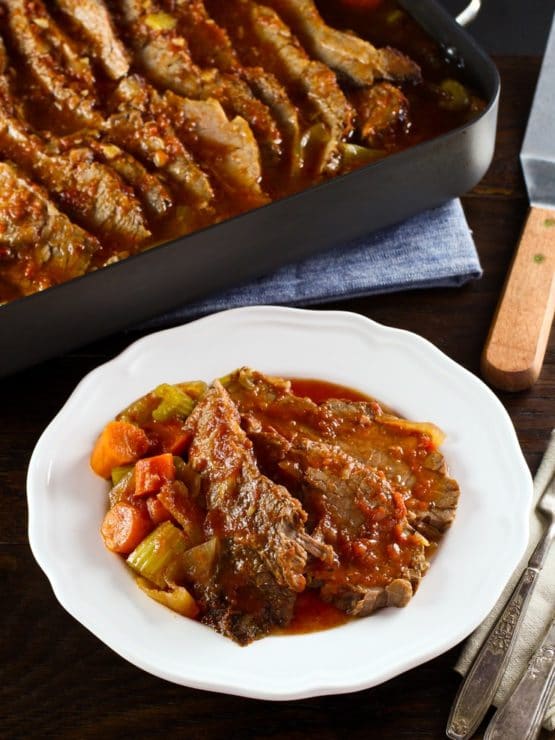
Jews living in Eastern Europe rarely had the money to buy better cuts of meat. They learned to make do with cheaper kosher cuts, like brisket, oft overlooked for its toughness. Cooking the brisket low and slow breaks it down, resulting in a tender piece of meat.
This Jewish tradition continues today, and brisket is often served for special holidays and occasions. On Shabbat, it is added to a pot with vegetables and potatoes to make a slow-cooked meaty stew known as cholent. At Rosh Hashanah, it is added to root vegetables with sweet dried fruits and slow cooked into tzimmes.
When Ashkenazi Jewish immigrants came to the United States, they brought their love of brisket with them. Jewish deli owners pickled the brisket to make corned beef or pastrami. But for the holidays, nothing could replace the comforting, hearty flavor of an oven-roasted brisket.
How to make brisket tender
The secret to a cooking brisket is twofold– brisket fat and time are key for tender and delicious results. Choose a cut with nice marbling; the more fat you can see, the more tender the meat will be. If buying grass fed (which tends to be leaner), make sure there is a fat layer and don’t let the butcher trim it. And of course, allow yourself plenty of time to cook your brisket. If you can, make it a day or two ahead– the flavor will improve with time. More tips here: How to Cook Brisket – Tips and Recipes
My Holiday Brisket slow cooks for hours, so the final product flakes tenderly and simply melts in your mouth. The sauce is rich and flavorful, and the slow cooked vegetables are soft, like butter. The flavor is perfect for any special celebration, but particularly suited to the Jewish holidays. Enjoy!
What is traditionally served with Brisket?
Olive Oil Mashed Potatoes with Garlic and Rosemary
Roasted Rosemary Balsamic Tzimmes
Butternut Squash and Crispy Kale Bake
Green Beans with Balsamic Date Reduction Feta and Pine Nuts
Kale and Roasted Beet Salad with Maple Balsamic Dressing
Throwback Recording: In this radio interview with Joan Hamburg, we talked about this very brisket recipe, as well as Passover cooking. You can listen by clicking the triangle “play” button below.
Recommended Products:
We are a participant in the Amazon Services LLC Associates Program, an affiliate advertising program designed to provide a means for us to earn fees by linking to Amazon.com and affiliated sites. As an Amazon Associate I earn from qualifying purchases.
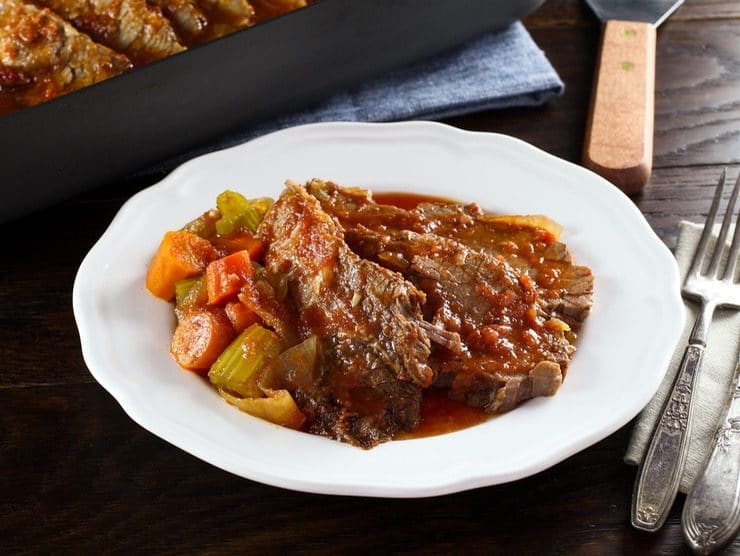
Food Photography and Styling by Kelly Jaggers
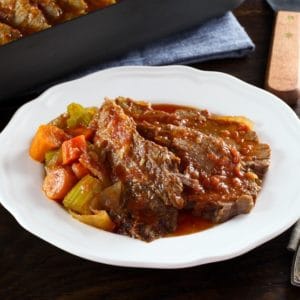
Holiday Brisket
Ingredients
- 5-7 pounds brisket, first or second cut (do not trim fat - especially if it's grass fed)
- 1/4 cup extra virgin olive oil, divided
- 2 large brown onions, peeled and sliced
- 1 pound carrots, peeled and sliced
- 1 pound celery, peeled and sliced
- 28 ounces tomatoes - whole, diced, or crushed (1 large can)
- 10 peeled whole garlic cloves
- 1/2 cup brown sugar
- 1/4 cup vinegar (I like apple cider vinegar, but white vinegar works too)
- 2 cups beef or chicken broth, divided
- Salt and pepper
NOTES
Instructions
- Preheat oven to 300 degrees F. Rinse the brisket and pat dry. Rub both sides of the meat with black pepper and salt. Heat a large skillet over a medium flame on the stovetop. Drizzle 2 tbsp of olive oil into the pan. Brown the brisket on both sides—it will take 4-5 minutes per side. A large brisket may overlap the edges of the skillet; you can brown it in stages, letting half the brisket overlap the edge, then adjusting it to brown the other half.

- While brisket is browning, pour canned tomatoes, garlic, brown sugar, apple cider vinegar, and 1 ½ cups broth into a blender or food processor. Add 2 tsp of salt (or 1 tsp if using a salted kosher cut of brisket) and ¼ tsp of black pepper. Pulse till garlic is chopped small and all ingredients are combined.

- Remove the browned brisket from the skillet.

- Drizzle 2 tbsp more olive oil in the pan and add the sliced onions. Saute them over medium high for a few minutes until they begin to soften and shrink in size.

- Add the carrot and celery slices. Sauté for another 5-6 minutes until the onions are soft and browning and the vegetables are fragrant.

- Pour the vegetables out of the skillet and onto a plate, reserve. Add 1/2 cup beef stock or chicken stock into the skillet and let it heat up. Use a spatula to gently scrape up any brown bits and pan juices that are clinging to the skillet. Turn off heat.

- Pour half of the tomato mixture into a large roasting pan.

- Place brisket on top of the tomato sauce, fat cap facing up.

- Pour the sauteed vegetables across the top of the brisket, along with the broth and brown bits.

- Pour the remaining tomato sauce over the top of the vegetables and brisket.

- Cover the roasting pan tightly with a layer of parchment paper followed by a layer of foil. The parchment forms a protective layer between the meat and sauce (which is acidic) and the foil.

- Place brisket in the oven. Let it roast undisturbed for 5 to 7 hours. It will take about 1 hour per pound of meat (leaner cuts of meat like grass fed may take longer—test for doneness). Brisket is ready when it flakes tenderly when pierced with a fork. You can let it cook even longer for a soft, shredded texture if that’s what you prefer. When fully cooked, the brisket will have shrunk in size.I recommend making this brisket ahead; allowing it to sit in the refrigerator for 1-2 nights will improve the flavor. If you would like to do this, skip ahead to where it says “Make Ahead Directions.” If you are not making ahead, continue reading.

- Remove brisket from the pan and let it rest on the cutting board fat-side up for 20-30 minutes. Meanwhile, pour the sauce and vegetables from the roasting pan into a smaller saucepan. Skim fat from the surface of the cooking sauce, then reheat the sauce till hot (not boiling).Cut fat cap off the brisket, then cut the brisket in thin slices against the grain. Serve topped with hot tomato sauce and softened veggies.

- Make Ahead Directions: Open the foil to vent and let the brisket slowly return to room temperature. Switch the brisket and sauce to a ceramic or glass dish (metal from the roasting pan can react with the acid in the sauce, which can cause an off taste if left to sit). Cover with plastic wrap and place in the refrigerator. Let the brisket chill overnight, or up to two days. You can also freeze the brisket if you prefer.

- 1-2 hours before serving, remove the brisket from the refrigerator and preheat your oven to 350 degrees F. The fat in the sauce will have risen to the top, turned white, and solidified. Use a spoon to scoop the fat bits out of the sauce and discard.

- Take the brisket out of the dish and brush any excess sauce back into the dish. Place brisket on a cutting board, fat-side up. Slice the meat cold—first cut the fat cap off the brisket, then cut the brisket in thin slices against the grain.

- Return the sliced meat to the dish and spoon sauce over it, making sure to spoon a little sauce between each slice. Cover the dish with a layer of parchment paper, then with foil, and place it in the oven.

- Let the brisket roast for 45-60 minutes until heated through. You can cook the brisket even longer to let it become more tender, if you wish. Serve with hot sauce and softened veggies. If you prefer, you can use a slow cooker to reheat. Set the slow cooker to high heat and cook until heated through, about 1 hour.

Nutrition

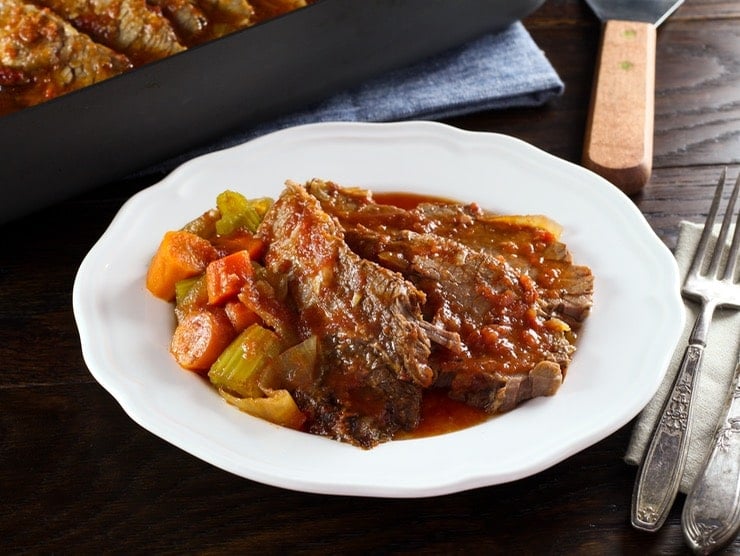
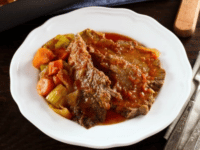
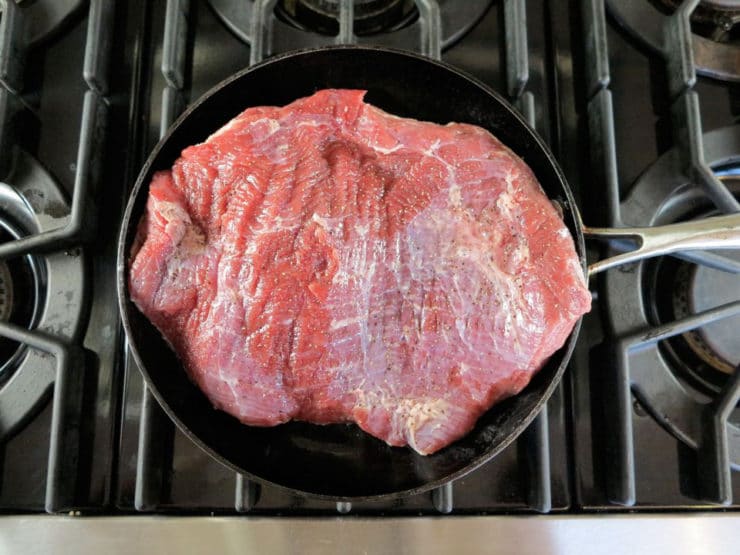
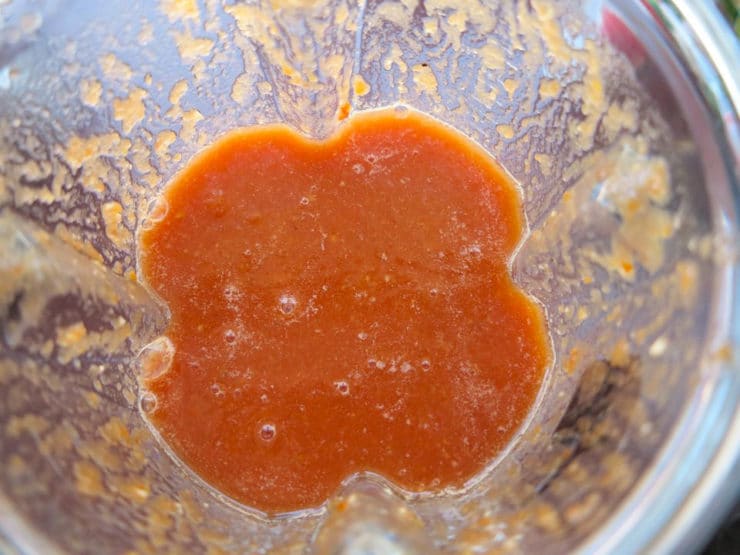
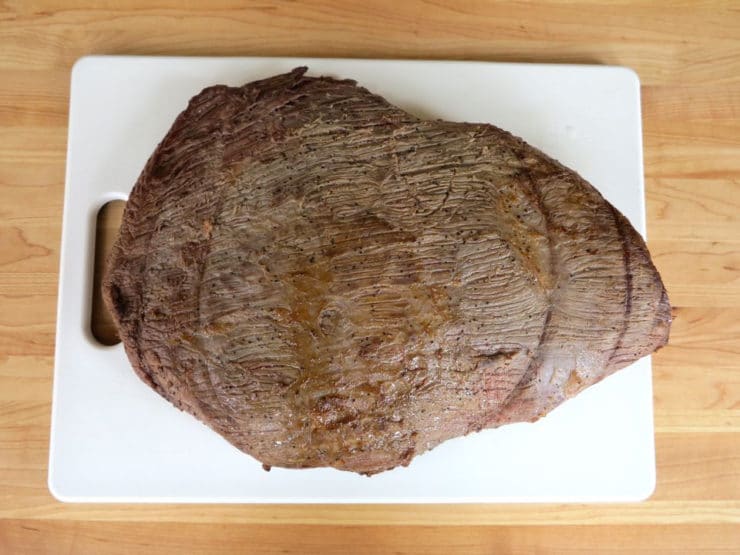


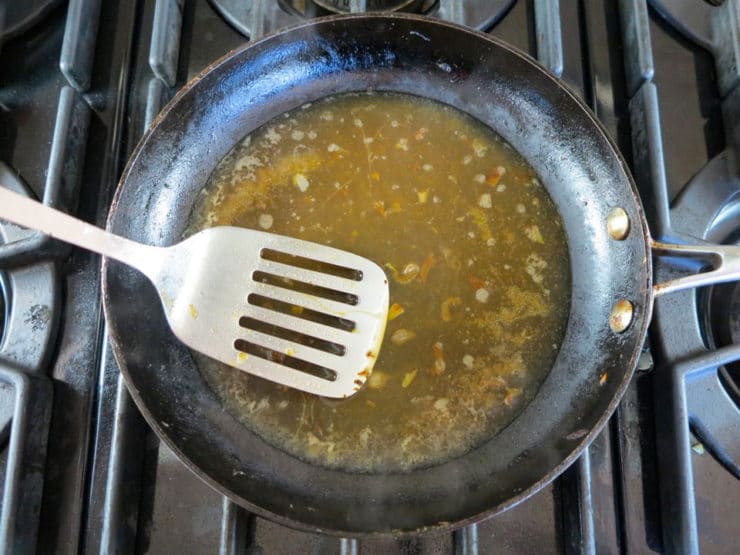
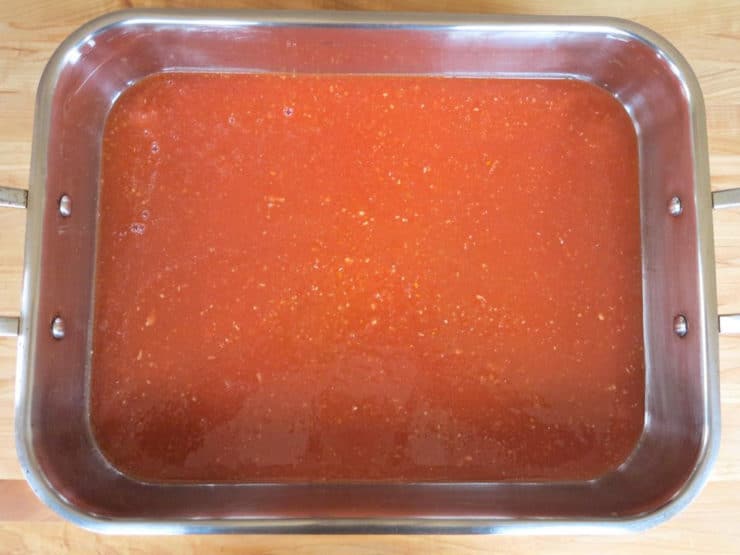
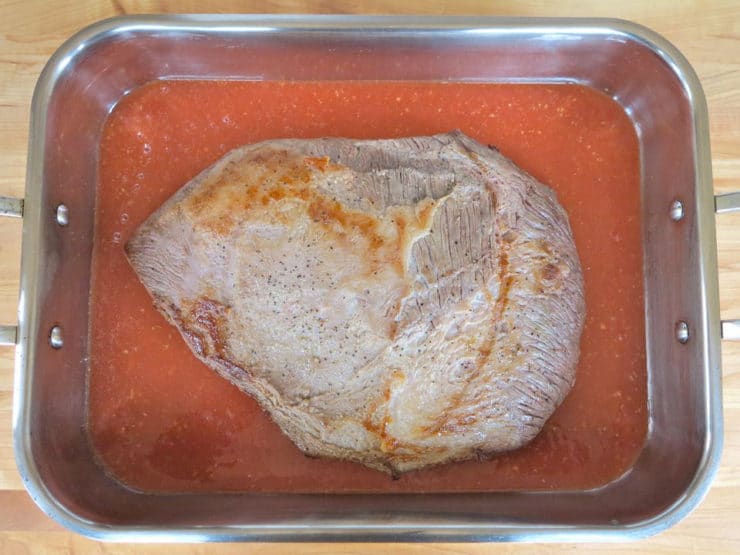
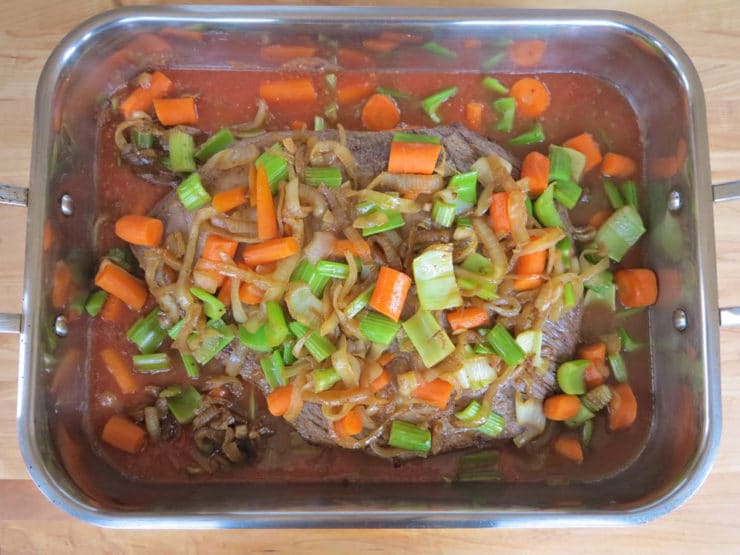
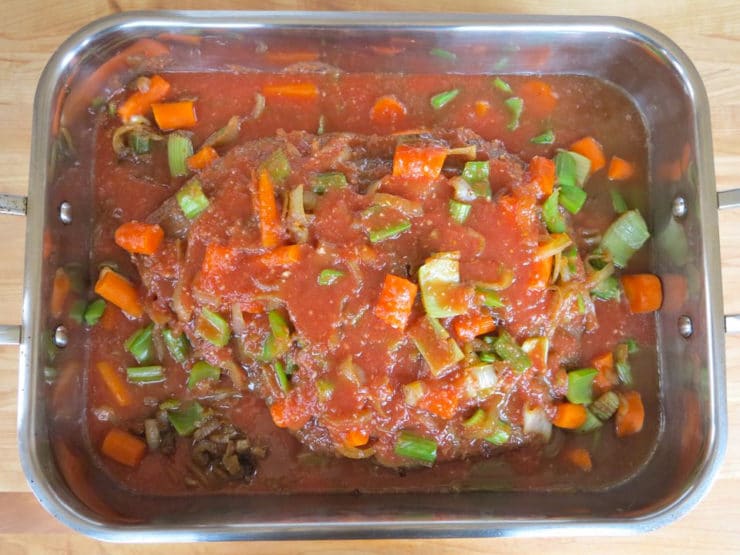

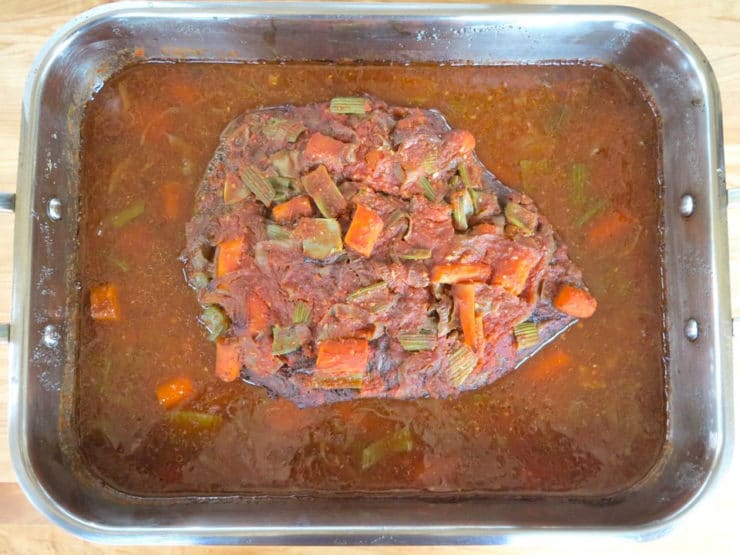
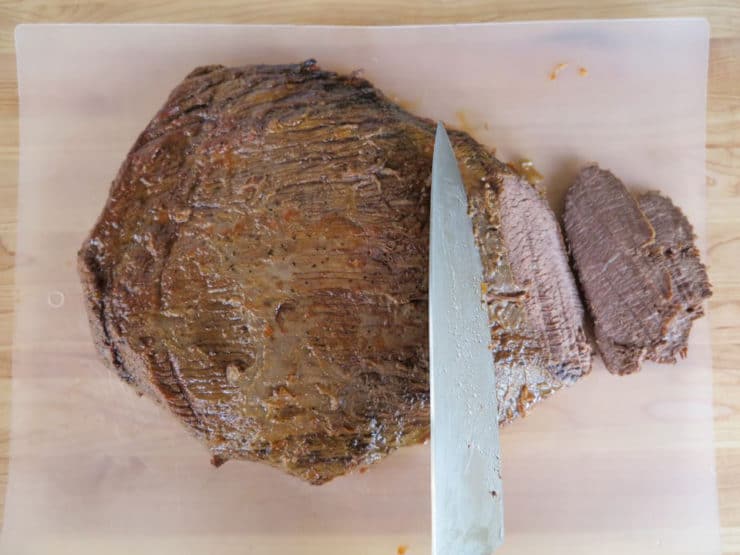
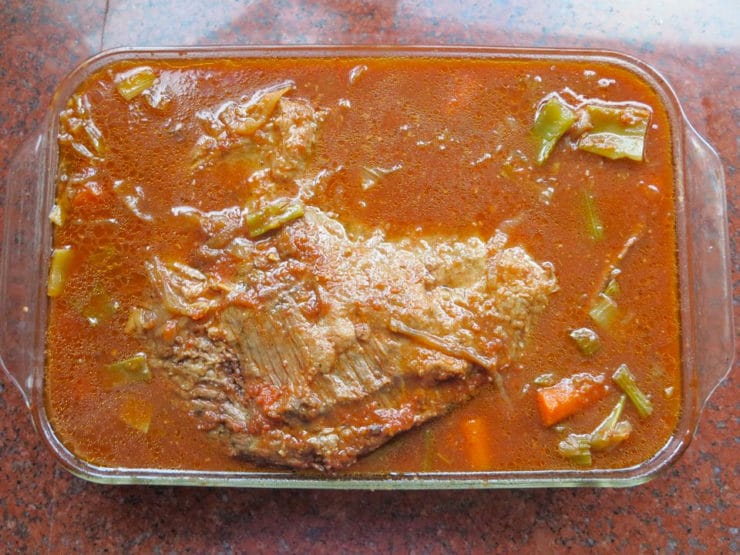
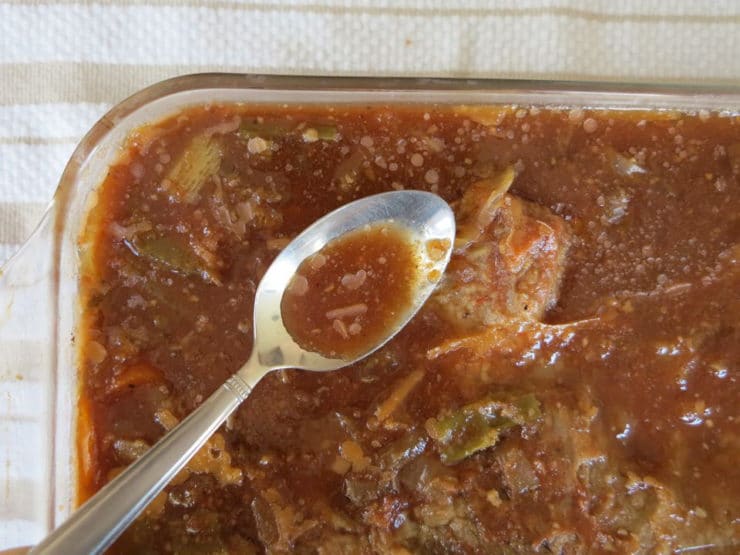
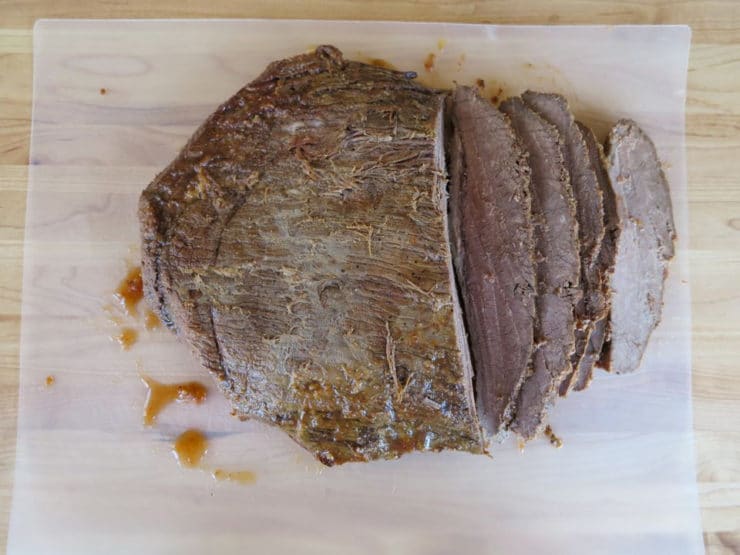
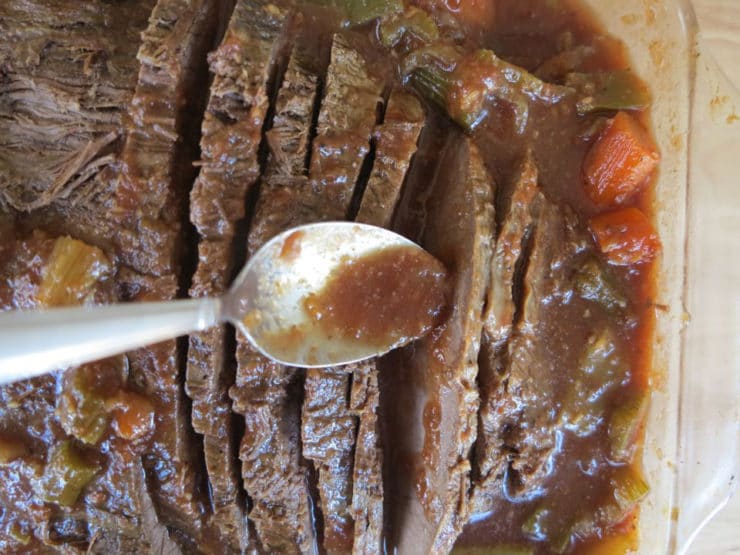
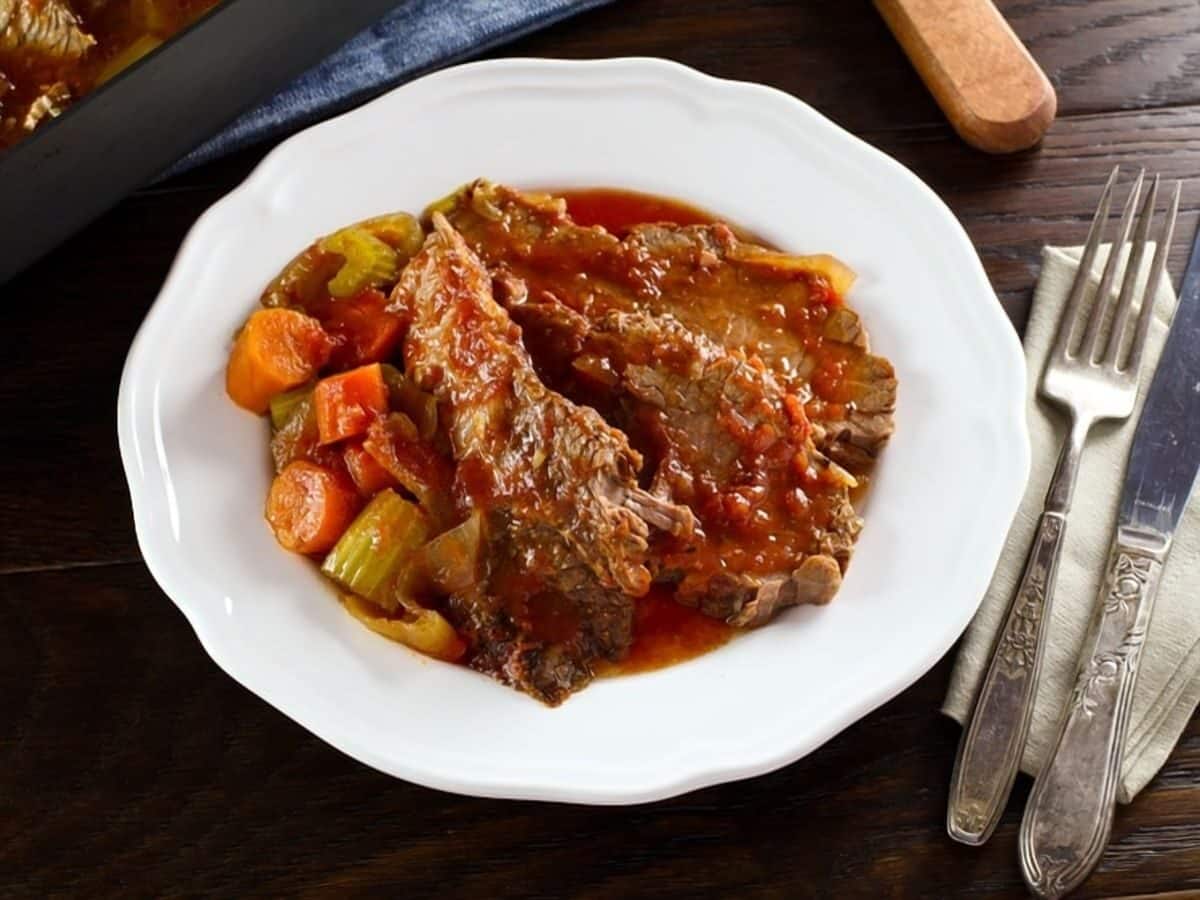


I love this recipe, and it is my family’s “must” for every holiday.
This year I bought a whole brisket, 12 pounds. The butcher cut it in half so I could brown it all
When the pieces are in the same roasting pan, how long do they need to cook: 7 hours, or closer to 14?
Should I cook on convection bake or regular bake? Should temp be adjusted if doing one or the other? I am wondering if this difference is causing some to have burnt or little sauce left?
This was tested on a regular bake setting. I have not tested it with convection – it might be the issue, yes, but can’t say without testing it myself.
I’ve made this brisket three times and it’s always a hit. So easy and so delicious. I normally use a slow cooker but for this year’s seder, I have a bigger crowd and a smaller crockpot. I’d imagine my 4.5 qt crockpot is way too small for 4-5lbs of brisket. First time cooking a brisket in the oven AND the first time making it the day before. Fingers crossed.
I am confident you’ll do great, Madison!
First time brisket maker here… and of course, the first time I’m making it is for my Jewish boyfriend’s family for Passover ( I am not Jewish) so….. NO PRESSURE!!!
I really don’t want to mess this up – and your recipe and the reviews seem like a winner, so here’s hoping I can do it justice!
I had a few questions though – a lot of other websites have mentioned brining the brisket beforehand, but is this really necessary, since it’s being covered and slow-cooked?
Also.. how many people would a 7lb brisket feed?? I’m thinking it should be enough for 10… but I’m not sure, since it shrinks a lot after cooking. What would you recommend for 10 people?
Any help would be greatly appreciated… the last thing I want is to disappoint his mum for Pesach!!
Thank you
Mariel
Hi Mariel, this recipe does not require any brining. Here is a guide for amounts needed for various weights of brisket: https://toriavey.com/toris-kitchen/lets-talk-brisket/ It’s a good post to review if you’ve never made brisket before. Enjoy!
I’m also making this recipe for the first time, but now I’m extremely invested in your success, Mariel, let us know how it goes!
My kids love this so much that I am asked to make it all the time! For any special occasion, this recipe makes an appearance. Thanks for sharing, Tori!
My family really enjoyed this, it was so yummy. It was my first time cooking brisket and I was so scared I would screw up this giant piece of meat my grandmother-in-law bought us to make for the whole family, but wow this turned out fabulous! I followed the recipe exactly except I took a commenter’s suggestion and added 3/4 tsp baking soda to the sauce just to make sure it wasn’t too acidic. Tori thank you for the recipe it’s now going to be my go to!!
First time ever making a Jewish brisket. It was amazing!!! Even the picky eater cleaned his plate. Happy Hanukkah!
This recipe is PERFECT! My new go-to. It was a huge hit at Hanukkah dinner 🙂
This one is a mic drop recipe Tori! Thank you for sharing it.
I’ve used this as my go-to brisket recipe for Rosh Hashannah for the last 4/5 years, and I can’t begin to tell you how wonderful it is. I’ve learned to make it a day or two in advance—it really does enhance the flavor. So thank you from me and my family!
I have a very thick brisket for some reason (not sure what the butcher gave me??) should i cook it longer?? its 6 lbs but looks more like the shape of a roast than a traditional brisket.
It really depends on the cut… might want to start cooking earlier in the day and check it often. I might take longer, but typically it seems to tenderize more by weight than thickness. No harm in it getting done earlier in the day, then reheating before serving. Good luck!
Whole briskets come with a flat and triangular shaped parts. Typically it’s broken down to two parts. The thicker cut is the known as the point, the flat is the other thinner cut typically used for the Jewish brisket recipes. The point is amazing for smoking and BBQ style cooking. It’s what you would find at a BBQ restaurant. The flat is much leaner and needs slow cooking and liquids to come out tender and moist.
Delicious, best brisket ever and so easy to make. The sauce/gravy is wonderful. Followed the recipe exactly.
Glad to hear it!
I’m cooking this in a dutch oven that I just put into the oven. Quick question: because the dutch oven is smaller than a roasting pan, the sauce runs nearly to the top and the brisket is immersed in liquid (rather than rising up from a shallower bath, as in the photo). Is that fine, or should more of the brisket be exposed? (I won’t expect a response before I have to take it out this evening, but at least I’ll know for next time!) Thanks so much for this wonderful recipe! I made it two years ago and our guests are still talking about it.
It should be fine Dustin! The only risk you run is that it will get overly tender in all of that cooking liquid, so continue checking it and take it out when it is tender and sliceable, but not falling apart completely. Enjoy! 🙂
Tori do we need parchment or can I just do foil?
I like to put the parchment layer, because foil can sometimes degrade while cooking, especially when it touches acidic sauces. But it’s not 100% necessary, just my preference.
My go-to brisket recipe. Borderline impossible to mess up and perfectly sweet-and-sour!
I have followed this recipe for years without fail and always recommend it to others. It is a crowd pleaser for sure. You’ve done it again, Tori!
This was the first time I made brisket and I couldn’t believe how good it was. This recipe is excellent!!
This was the most delicious brisket I ever had in my whole life. The recipe is easy to make and the result was fantastic. Thank you very much for sharing it with us!
Tori,.
You are always my go-to guru chef. Thanks for your recipe for Brisket. Hag Sameach /Shabbat shalom.
Jeff Allon
The recipe was delicious, we had a beautiful and delicious pesah!
Just a headsup: I used the recipe for less people than 12 (the original amount), note that the text in the instructions doesn’t change automatically.
Another thing, even though I put the amount of sugar I was suppose to (but brown), the sauce was very acidic. I found a cool solution — add 1/4 tea spoon baking powder for every cup of sauce, it did miracles! The sauce became more thick and sweeter.
I have been making brisket for Passover for decades. This is by far the best recipe I have ever used. It is totally delicious!!! Flavorful, juicy, tender, just very special!!